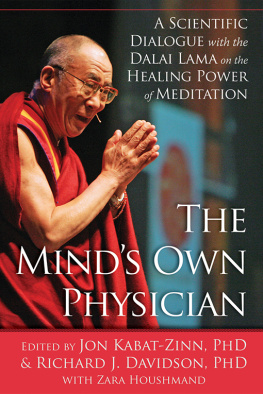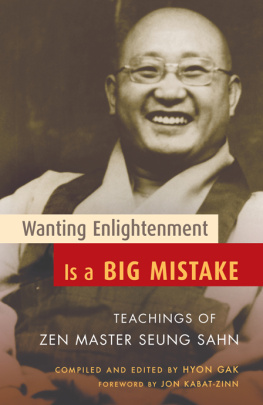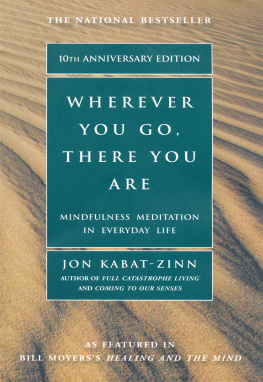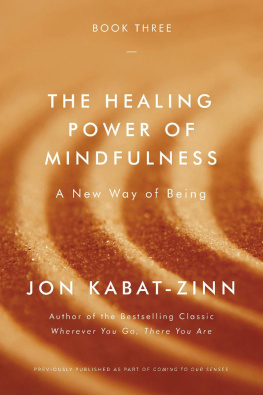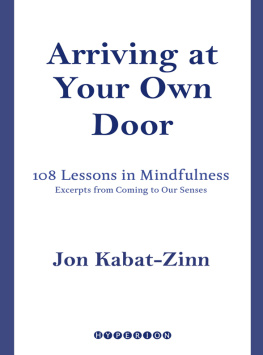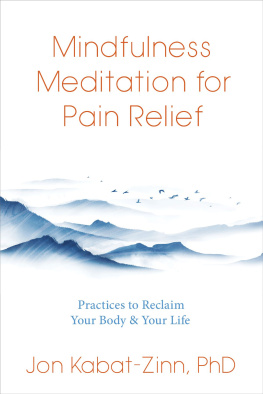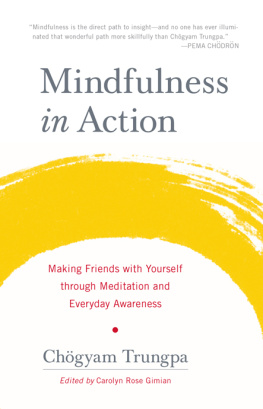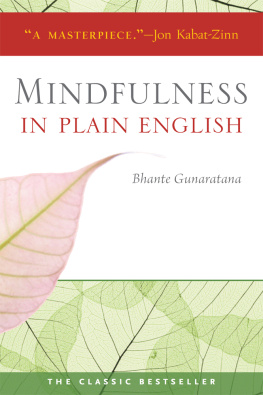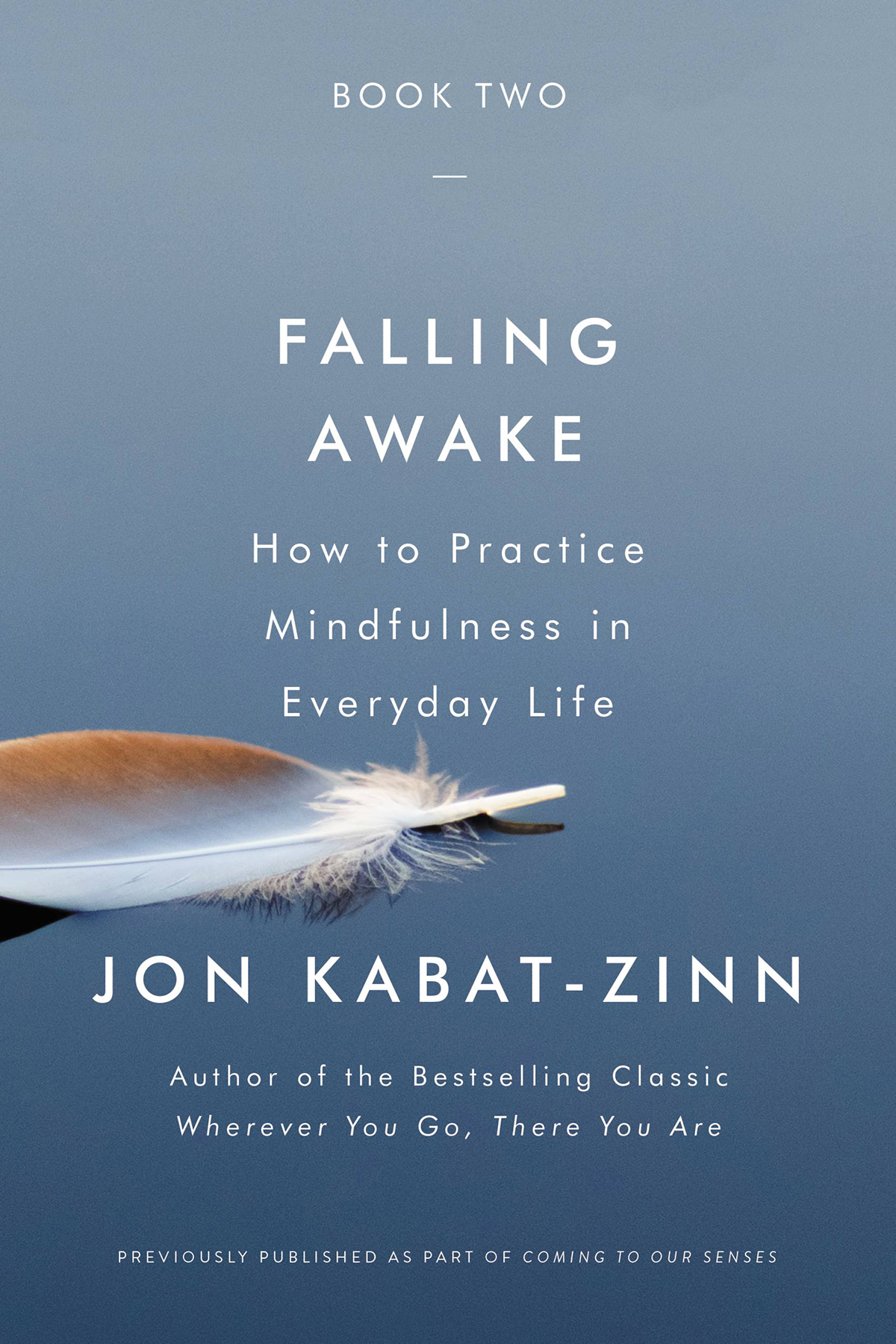Thank you for buying this ebook, published by HachetteDigital.
To receive special offers, bonus content, and news about ourlatest ebooks and apps, sign up for our newsletters.
Copyright 2018 by Jon Kabat-Zinn, Ph.D.
Cover design by Joanne ONeill
Cover copyright 2018 by Hachette Book Group, Inc.
Hachette Book Group supports the right to free expression and the value of copyright. The purpose of copyright is to encourage writers and artists to produce the creative works that enrich our culture.
The scanning, uploading, and distribution of this book without permission is a theft of the authors intellectual property. If you would like permission to use material from the book (other than for review purposes), please contact permissions@hbgusa.com. Thank you for your support of the authors rights.
Hachette Books
Hachette Book Group
1290 Avenue of the Americas
New York, NY 10104
hachettebooks.com
twitter.com/hachettebooks
Originally published in hardcover as part of Coming to Our Senses by Hyperion in January 2005.
First Edition: August 2018
Credits and permissions appear beginning on and constitute a continuation of the copyright page.
Hachette Books is a division of Hachette Book Group, Inc.
The Hachette Books name and logo are trademarks of Hachette Book Group, Inc.
The publisher is not responsible for websites (or their content) that are not owned by the publisher.
The Hachette Speakers Bureau provides a wide range of authors for speaking events. To find out more, go to www.hachettespeakersbureau.com or call (866) 376-6591.
Library of Congress Control Number: 2018934793
ISBNs: 978-0-316-41175-2 (trade paperback), 978-0-316-52197-0 (ebook)
E3-20180719-JV-PC
MEDITATION IS NOT WHAT YOU THINK: Mindfulness and Why It Is So Important
THE HEALING POWER OF MINDFULNESS: A New Way of Being
MINDFULNESS FOR ALL: The Wisdom to Transform the World
MINDFULNESS:
Diverse Perspectives on Its Meaning, Origins, and Applications
(editor, with J. Mark G. Williams)
MINDFULNESS FOR BEGINNERS:
Reclaiming the Present Momentand Your Life
THE MINDS OWN PHYSICIAN:
A Scientific Dialogue with the Dalai Lama on the Healing Power of Meditation
(editor, with Richard J. Davidson)
LETTING EVERYTHING BECOME YOUR TEACHER:
100 Lessons in Mindfulness
ARRIVING AT YOUR OWN DOOR:
108 Lessons in Mindfulness
THE MINDFUL WAY THROUGH DEPRESSION:
Freeing Yourself from Chronic Unhappiness
(with Mark Williams, John Teasdale, and Zindel Segal)
COMING TO OUR SENSES:
Healing Ourselves and the World Through Mindfulness
EVERYDAY BLESSINGS:
The Inner Work of Mindful Parenting
(with Myla Kabat-Zinn)
WHEREVER YOU GO, THERE YOU ARE:
Mindfulness Meditation in Everyday Life
FULL CATASTROPHE LIVING:
Using the Wisdom of Your Body and Mind to Face Stress, Pain, and Illness
for Myla
for Stella, Asa, and Toby
for Will and Teresa
for Naushon
for Serena
for the memory of Sally and Elvin and Howie and Roz
for all those who care
for what is possible
for what is so
for wisdom
for clarity
for kindness
for love
What do we mean when we talk about cultivating mindfulness?
There is no question that mindfulness is one of the hardest things in the world for us humans to tap into consistently (even though it is not a thing), and even though we can taste it and recognize that experience of tasting in an instant, in any instant.
The invitation is always the same: to stop for a momentjust one momentand drop into wakefulness. That is all. Stop and drop: meaning, drop in to your experience of experiencing, and for even the briefest of moments, simply holding it in awareness as it isin no time, or to put it differently, in this timeless moment we call now, the only moment we actually ever have.
Luckily, if we miss this moment because we are distracted by one thing or another, caught up in thinking or in our emotions, or with the busyness of what always seems to need getting done, there is always the next moment to begin again, to stop and drop into wakefulness in this moment of now.
It seems so simple. And it is.
But it is not easy.
In fact, looked at one way, a moment of mindfulness, with no agenda whatsoever other than to be aware, is just about the hardest thing in the world for us humans to come to. And it is even harder for us to string two moments of mindfulness together.
And yet, paradoxically, mindfulness doesnt involve doing anything at all. In fact, it is a non-doing, a radical non-doing. And right inside any moment of non-doing lies peace, insight, creativity, and new possibilities in the face of old habits of mind and old habits of living. Right in that or any moment of non-doing, you are already OK, already perfect, in the sense of perfectly who and what you are. And therefore, right in that moment you are already at home in a profound way, far beyond who you think you are and the ideas and opinions that may so shape and sometimes severely limit your view of the larger whole. Not to mention your own possibilities for experiencing that wholeness and benefiting from it. And most interesting of all is the realization that there is no that moment at some other time, except in thought. In actuality, there is only this moment for dropping in.
None of this means that you wont get things done. In fact, when your doing comes out of being, when it is truly a non-doing, it is a far better doing and far more creative and even effortless than when we are striving to get things done without an ongoing awareness moment by moment. When our doing comes out of being, it becomes an integral and intimate part of a love affair with awareness itself, and with our ability to inhabit that space in our own mind and heart and to share it with others who are also engaged in that way of being as wellpotentially all of us.
And none of this means, as is described in considerable detail in all four books in this series, that what you are experiencing has to always be pleasanteither during formal meditation practice or in the unfolding of your life. It wont be. And it cant be. The only reason mindfulness is of any value is that it is profoundly and completely up to the challenge of relating wisely to any experiencewhether it is pleasant, unpleasant, or neutral, wanted or unwanted, even horrific or unthinkable. Mindfulness is capable of meeting and embracing suffering head-on, if and when it is suffering that is predominating at a particular moment or time in your life.
We dont learn much, if anything, about non-doing in school, but most of us have experienced moments of radical non-doing as children. In fact, tons of them. Sometimes it comes as wonder. Sometimes it looks like play. Sometimes it emerges as concern for someone else, a moment of kindness.
Another way to put it is that mindfulness is all about being, as in human being, and about life unfolding here and now, as it is, and embraced in awareness. Therefore, it takes virtually no effort because it is already happening. All it requires is learning to reside in your direct experiencing of this moment, whatever it is, without necessarily thinking that it is particularly yours. After all, even you is just a thought construct when you put it under the microscope and examine it. If you do, you may discover that who you think you are is a very small and at least partially inaccurate account of who and what you actually are. In an instant, you can recognize how large the full dimensionality of your own being really is. You are already whole, already completeas you are. And at the same time, you are part of a much larger whole, however you care to define it. And that larger whole, lets call it the world, sorely needs that fully embodied and more realized version of you.


